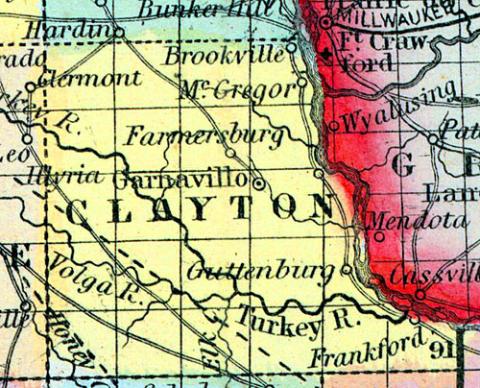GARNAVILLO. or GARNAVILLE, a thriving post-village, capital of Clayton county, Iowa, on the mail route from Dubuque to Prairie du Chien, about 100 miles N. by E. from Iowa City. It is pleasantly situated on a high, rolling prairie. Lead is abundant in the vicinity. (Baldwin's New and Complete Gazetteer of the United States..., 1854)
GARNAVILLO is a post village and township in the eastern interior of the county.[Clayton County, Iowa] The village is twelve miles southwest from McGregor, and forty-eight miles northwest from DuBuque by stage, and six miles from the Mississippi River. Shipments are made during the winter months via McGregor, and in the summer principally via Clayton and Dunleith. In April, 1845, two of the commissioners, Hardin Nowlin, of DuBuque County, and David Moreland, of Delaware County, met, pursuant to an “act to re-locate the county seat of Clayton County, and selected the north half of southeast quarter, section 18, township 93, north of range 3, west 5th principal meridian, and named it Jacksonville.
James Watson donated the land (eighty acres) so selected, and the County Commissioners immediately laid out the town, and commenced the erection of county buildings. April 15th, 1846, the name of the village was changed to Garnavillo.
James Watson, Dr. Frederick Andros, Capt. Robert R. Read, John W. Gillet, Richard Only, George A. Whitman, Judge Samuel Murdock, Reuben Noble and Judge Elias H. Williams, were among the first settlers.
There are two good flouring mills and two saw mills on Buck Creek, just east of the village; also one brewery, one hotel and several stores in the town.
The village is located on a beautiful and very productive prairie, which produces abundant crops of spring wheat, oats, corn and barley. There is an abundant supply of oak, elm and black walnut timber in the vicinity both for building and fuel; also stone quarries and a good quality of clay for making brick. Apples grow well, and pears, plums, and cherries are grown to some extent.
There are four churches, Methodist, Congregational, German Lutheran and Catholic; one lodge of Masons, one of Independent Order of Odd Fellows and one of Independent Order of Good Templars. Estimated population, 500. (Hair's Iowa State Gazetteer..., 1865)

